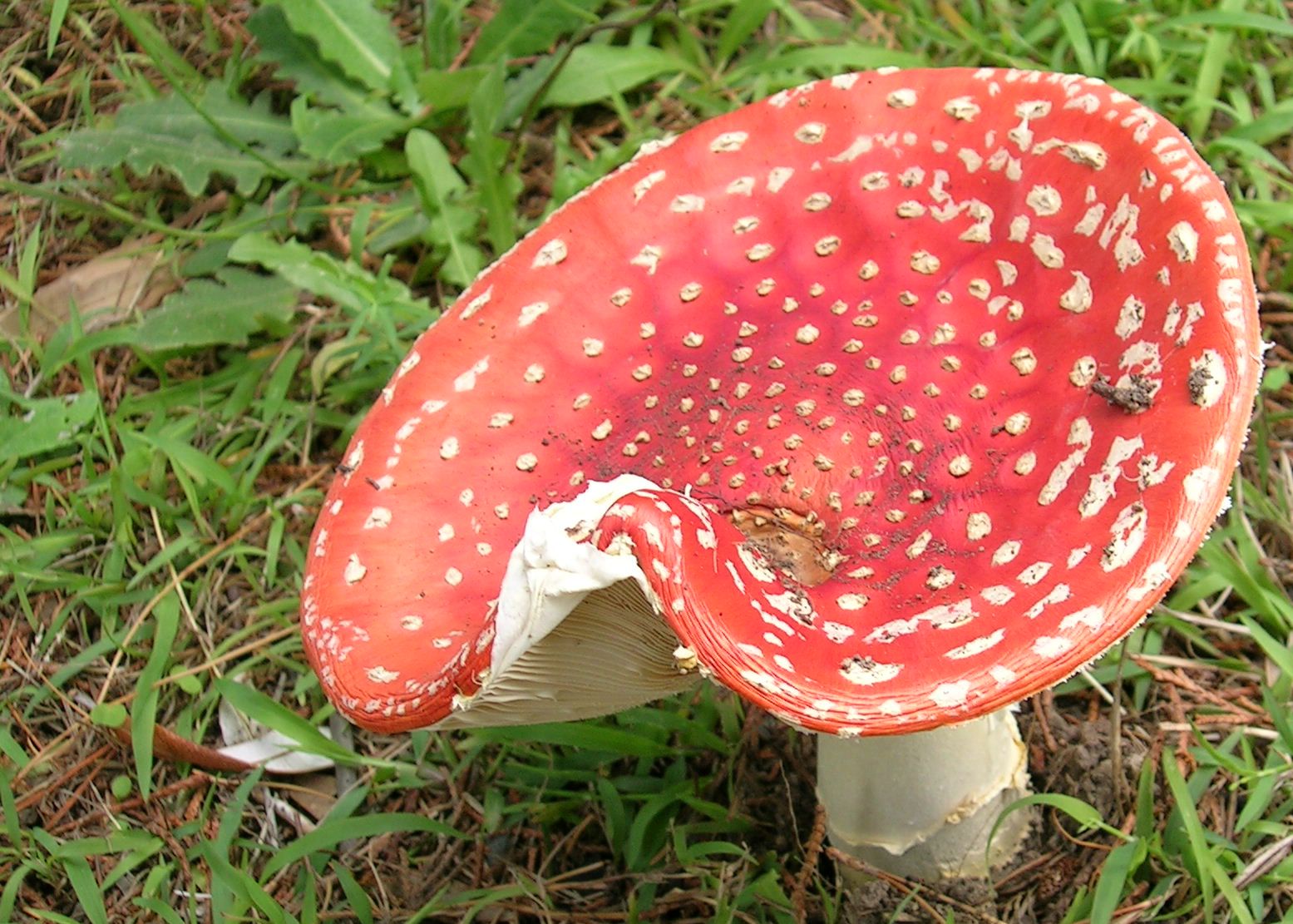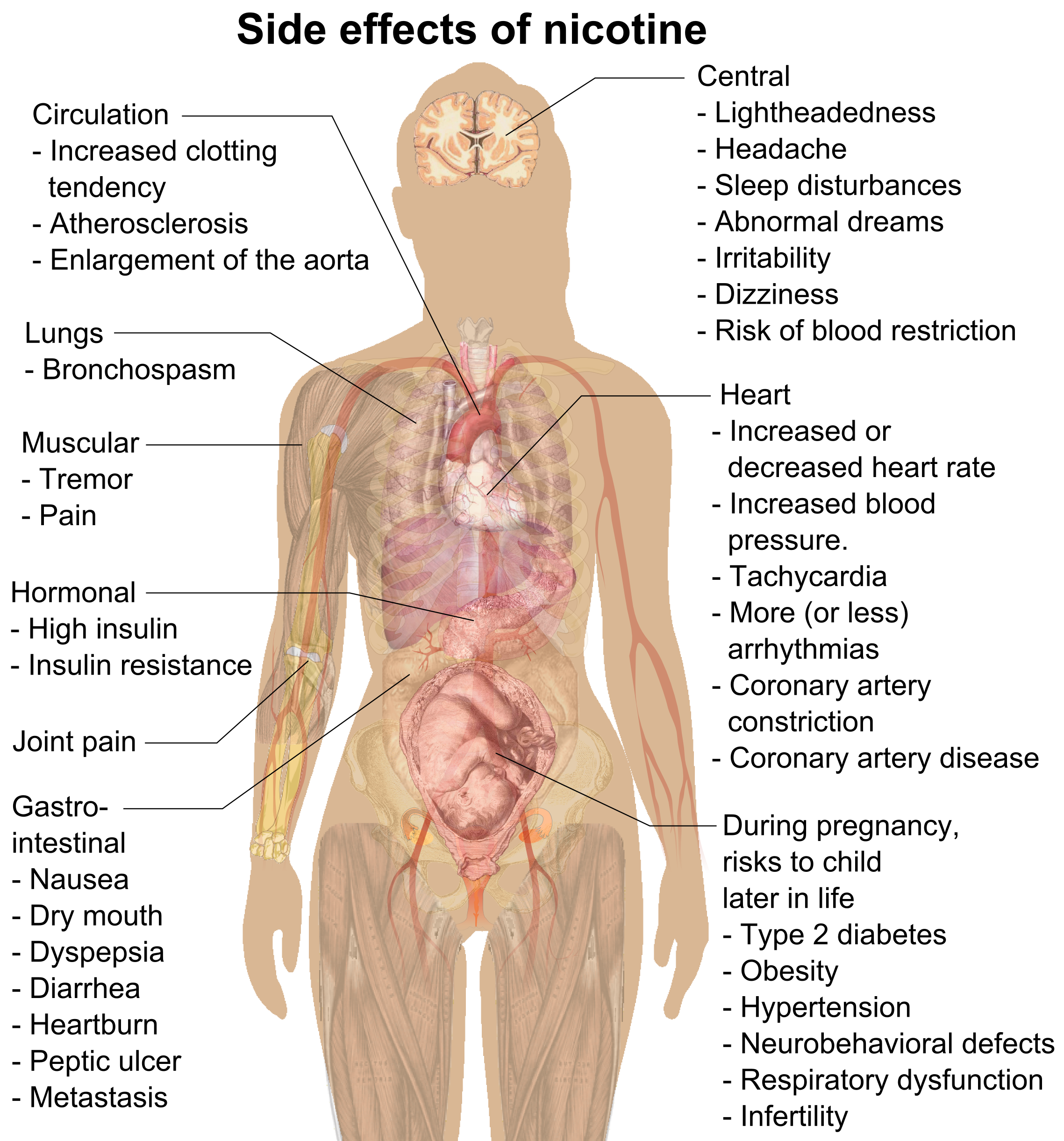|
Parasympathomimetic
A parasympathomimetic drug, sometimes called a cholinomimetic drug or cholinergic receptor stimulating agent, is a substance that stimulates the parasympathetic nervous system (PSNS). These chemicals are also called cholinergic drugs because acetylcholine (ACh) is the neurotransmitter used by the PSNS. Chemicals in this family can act either directly by stimulating the nicotinic or muscarinic receptors (thus mimicking acetylcholine), or indirectly by inhibiting cholinesterase, promoting acetylcholine release, or other mechanisms. Common uses of parasympathomimetics include glaucoma, sjögren syndrome and underactive bladder. Some chemical weapons such as sarin or VX, non-lethal riot control agents such as tear gas, and insecticides such as diazinon fall into this category. Structure activity relationships for parasympathomimetic drugs For a cholinergic agent, the following criteria describe the structure activity relationship: # Ing's Rule of 5: there should be no more than five ... [...More Info...] [...Related Items...] OR: [Wikipedia] [Google] [Baidu] |
Bethanechol
Bethanechol is a parasympathomimetic choline carbamate that selectively stimulates muscarinic receptors without any effect on nicotinic receptors. Unlike acetylcholine, bethanechol is not hydrolyzed by cholinesterase and will therefore have a long duration of action. Bethanechol is sold under the brand names Duvoid (Roberts), Myotonachol (Glenwood), Urecholine (Merck Frosst) and Urocarb (Hamilton). The name bethanechol refers to its structure as the urethane of beta-methylcholine. Medical uses Bethanechol alleviates dry mouth and is sometimes given orally or subcutaneously to treat urinary retention resulting from general anesthetic, diabetic neuropathy of the bladder, or a side effect of antidepressants; or to treat gastrointestinal lack of muscular tone. The muscarinic receptors in the bladder and gastrointestinal tract stimulate contraction of the bladder and expulsion of urine, and increased gastrointestinal motility, respectively. Bethanechol should be used to treat th ... [...More Info...] [...Related Items...] OR: [Wikipedia] [Google] [Baidu] |
Carbachol
Carbachol, also known as carbamylcholine and sold under the brand name Miostat among others, is a cholinomimetic drug that binds and activates acetylcholine receptors. Thus it is classified as a cholinergic agonist. It is primarily used for various ophthalmic purposes, such as for treating glaucoma, or for use during ophthalmic surgery. It is generally administered as an ophthalmic solution (i.e., eye drops). Carbachol produces effects comparable to those of sarin if a massive overdose is administered (as may occur following industrial and shipping accidents) and therefore it is classified as an extremely hazardous substance in the United States as defined in Section 302 of the U.S. Emergency Planning and Community Right-to-Know Act (42 U.S.C. 11002), and is subject to strict reporting requirements by facilities which produce, store, or use it in significant quantities. It is on the World Health Organization's List of Essential Medicines. Chemistry and pharmacology Carbach ... [...More Info...] [...Related Items...] OR: [Wikipedia] [Google] [Baidu] |
Underactive Bladder
Underactive bladder syndrome (UAB) describes symptoms of difficulty with bladder emptying, such as hesitancy to start the stream, a poor or intermittent stream, or sensations of incomplete bladder emptying. The physical finding of detrusor activity of insufficient strength or duration to ensure efficient bladder emptying is properly termed "detrusor underactivity" (DU). Historically, UAB and DU (as well as others such as 'bladder underactivity') have been often used interchangeably, leading to both terminologic and pathophysiologic confusion. Patients with underactive bladder have a diminished sense of bladder filling and consequently are often found to have DU as an underlying finding, however bladder outlet obstruction and less frequently volume hypersensitivity ("OAB") can be associated with UAB symptoms Causes Without diagnostic evaluation, the cause of underactive bladder is unclear, as there are multiple possible causes. UAB symptoms can accurately reflect impaired blad ... [...More Info...] [...Related Items...] OR: [Wikipedia] [Google] [Baidu] |
Glaucoma
Glaucoma is a group of eye diseases that result in damage to the optic nerve (or retina) and cause vision loss. The most common type is open-angle (wide angle, chronic simple) glaucoma, in which the drainage angle for fluid within the eye remains open, with less common types including closed-angle (narrow angle, acute congestive) glaucoma and normal-tension glaucoma. Open-angle glaucoma develops slowly over time and there is no pain. Peripheral vision may begin to decrease, followed by central vision, resulting in blindness if not treated. Closed-angle glaucoma can present gradually or suddenly. The sudden presentation may involve severe eye pain, blurred vision, mid-dilated pupil, redness of the eye, and nausea. Vision loss from glaucoma, once it has occurred, is permanent. Eyes affected by glaucoma are referred to as being glaucomatous. Risk factors for glaucoma include increasing age, high pressure in the eye, a family history of glaucoma, and use of steroid medicatio ... [...More Info...] [...Related Items...] OR: [Wikipedia] [Google] [Baidu] |
M3 Receptors
The muscarinic acetylcholine receptor, also known as cholinergic/acetylcholine receptor M3, or the muscarinic 3, is a muscarinic acetylcholine receptor encoded by the human gene CHRM3. The M3 muscarinic receptors are located at many places in the body, e.g., smooth muscles, the endocrine glands, the exocrine glands, lungs, pancreas and the brain. In the CNS, they induce emesis. Muscarinic M3 receptors are expressed in regions of the brain that regulate insulin homeostasis, such as the hypothalamus and dorsal vagal complex of the brainstem. These receptors are highly expressed on pancreatic beta cells and are critical regulators of glucose homoestasis by modulating insulin secretion. In general, they cause smooth muscle contraction and increased glandular secretions. They are unresponsive to PTX and CTX. Mechanism Like the M1 muscarinic receptor, M3 receptors are coupled to G proteins of class Gq, which upregulate phospholipase C and, therefore, inositol trisphosphate and ... [...More Info...] [...Related Items...] OR: [Wikipedia] [Google] [Baidu] |
Muscarinic Receptors
Muscarinic acetylcholine receptors, or mAChRs, are acetylcholine receptors that form G protein-coupled receptor complexes in the cell membranes of certain neurons and other cells. They play several roles, including acting as the main end-receptor stimulated by acetylcholine released from postganglionic fibers in the parasympathetic nervous system. Muscarinic receptors are so named because they are more sensitive to muscarine than to nicotine. Their counterparts are nicotinic acetylcholine receptors (nAChRs), receptor ion channels that are also important in the autonomic nervous system. Many drugs and other substances (for example pilocarpine and scopolamine) manipulate these two distinct receptors by acting as selective agonists or antagonists. Function Acetylcholine (ACh) is a neurotransmitter found in the brain, neuromuscular junctions and the autonomic ganglia. Muscarinic receptors are used in the following roles: Recovery receptors ACh is always used as the ... [...More Info...] [...Related Items...] OR: [Wikipedia] [Google] [Baidu] |
Arecoline
Arecoline () is a nicotinic acid-based mild parasympathomimetic stimulant alkaloid found in the areca nut, the fruit of the areca palm ('' Areca catechu''). It is an odourless oily liquid. It can bring a sense of enhanced alertness and energy, euphoria and relaxation. Its psychoactive effects are comparable to that of nicotine. Chemistry Arecoline is a base, and its conjugate acid has a pKa ~ 6.8. Arecoline is volatile in steam, miscible with most organic solvents and water, but extractable from water by ether in presence of dissolved salts. Being basic, arecoline forms salts with acids. The salts are crystalline, but usually deliquescent: the hydrochloride, arecoline•HCl, forms needles, m.p. 158 °C; the hydrobromide, arecoline•HBr, forms slender prisms, mp. 177–179 °C from hot alcohol; the aurichloride, arecoline•HAuCl4, is an oil, but the platinichloride, arecoline2•H2PtCl6, mp. 176 °C, crystallizes from water in orange-red rhombohedrons ... [...More Info...] [...Related Items...] OR: [Wikipedia] [Google] [Baidu] |
Muscarinic Acetylcholine Receptor
Muscarinic acetylcholine receptors, or mAChRs, are acetylcholine receptors that form G protein-coupled receptor, G protein-coupled receptor complexes in the cell membranes of certain neurons and other Cell (biology), cells. They play several roles, including acting as the main end-receptor stimulated by acetylcholine released from postganglionic fibers in the parasympathetic nervous system. Muscarinic receptors are so named because they are more sensitive to muscarine than to nicotine. Their counterparts are nicotinic acetylcholine receptors (nAChRs), receptor ion channels that are also important in the autonomic nervous system. Many drugs and other substances (for example pilocarpine and Hyoscine hydrobromide, scopolamine) manipulate these two distinct receptors by acting as selective agonists or receptor antagonist, antagonists. Function acetylcholine, Acetylcholine (ACh) is a neurotransmitter found in the brain, neuromuscular junctions and the autonomic ganglia. Muscarini ... [...More Info...] [...Related Items...] OR: [Wikipedia] [Google] [Baidu] |
Muscarine
Muscarine, L-(+)-muscarine, or muscarin is a natural product found in certain mushrooms, particularly in '' Inocybe'' and '' Clitocybe'' species, such as the deadly '' C. dealbata''. Mushrooms in the genera '' Entoloma'' and '' Mycena'' have also been found to contain levels of muscarine which can be dangerous if ingested. Muscarine has been found in harmless trace amounts in '' Boletus'', '' Hygrocybe'', ''Lactarius'' and ''Russula''. Trace concentrations of muscarine are also found in ''Amanita muscaria'', though the pharmacologically more relevant compound from this mushroom is the Z-drug-like alkaloid muscimol. ''A. muscaria'' fruitbodies contain a variable dose of muscarine, usually around 0.0003% fresh weight. This is very low and toxicity symptoms occur very rarely. ''Inocybe'' and ''Clitocybe'' contain muscarine concentrations up to 1.6%. Muscarine is a nonselective agonist of the muscarinic acetylcholine receptors. History The name ''muscarine'' derives fro ... [...More Info...] [...Related Items...] OR: [Wikipedia] [Google] [Baidu] |
Cholinergic
Cholinergic agents are compounds which mimic the action of acetylcholine and/or butyrylcholine. In general, the word "choline" describes the various quaternary ammonium salts containing the ''N'',''N'',''N''-trimethylethanolammonium cation. Found in most animal tissues, choline is a primary component of the neurotransmitter acetylcholine and functions with inositol as a basic constituent of lecithin. Choline also prevents fat deposits in the liver and facilitates the movement of fats into cells. The parasympathetic nervous system, which uses acetylcholine almost exclusively to send its messages, is said to be almost entirely cholinergic. Neuromuscular junctions, preganglionic neurons of the sympathetic nervous system, the basal forebrain, and brain stem complexes are also cholinergic, as are the receptor for the merocrine sweat glands. In neuroscience and related fields, the term cholinergic is used in these related contexts: * A substance (or ligand) is cholinergic i ... [...More Info...] [...Related Items...] OR: [Wikipedia] [Google] [Baidu] |
Acetylcholine Receptors
An acetylcholine receptor (abbreviated AChR) is an integral membrane protein that responds to the binding of acetylcholine, a neurotransmitter. Classification Like other transmembrane receptors, acetylcholine receptors are classified according to their "pharmacology," or according to their relative affinities and sensitivities to different molecules. Although all acetylcholine receptors, by definition, respond to acetylcholine, they respond to other molecules as well. *Nicotinic acetylcholine receptors (''nAChR'', also known as "ionotropic" acetylcholine receptors) are particularly responsive to nicotine. The nicotine ACh receptor is also a Na+, K+ and Ca2+ ion channel. *Muscarinic acetylcholine receptors (''mAChR'', also known as "metabotropic" acetylcholine receptors) are particularly responsive to muscarine. Nicotinic and muscarinic are two main kinds of "cholinergic" receptors. Receptor types Molecular biology has shown that the nicotinic and muscarinic receptors belong ... [...More Info...] [...Related Items...] OR: [Wikipedia] [Google] [Baidu] |
Nicotine
Nicotine is a naturally produced alkaloid in the nightshade family of plants (most predominantly in tobacco and '' Duboisia hopwoodii'') and is widely used recreationally as a stimulant and anxiolytic. As a pharmaceutical drug, it is used for smoking cessation to relieve withdrawal symptoms. Nicotine acts as a receptor agonist at most nicotinic acetylcholine receptors (nAChRs), except at two nicotinic receptor subunits ( nAChRα9 and nAChRα10) where it acts as a receptor antagonist. Nicotine constitutes approximately 0.6–3.0% of the dry weight of tobacco. Nicotine is also present at ppb-concentrations in edible plants in the family Solanaceae, including potatoes, tomatoes, and eggplants, though sources disagree on whether this has any biological significance to human consumers. It functions as an antiherbivore toxin; consequently, nicotine was widely used as an insecticide in the past, and neonicotinoids (structurally similar to nicotine), such as imidaclopri ... [...More Info...] [...Related Items...] OR: [Wikipedia] [Google] [Baidu] |




